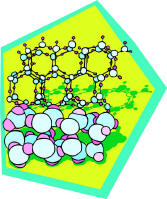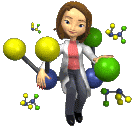|
IONS, MOLECULES,
AND COMPOUNDS
 An
element that has a charge is called an "ion." An ion
can be an atom or a molecule that has either lost or gained electrons.
A negative ion is called an anion and has an excess of electrons
compared to the protons in the nucleus. A positive ion is known as a
cation and has a fewer electrons. An ion that is composed of a
single element is called a monatomic ion. A cation is An
element that has a charge is called an "ion." An ion
can be an atom or a molecule that has either lost or gained electrons.
A negative ion is called an anion and has an excess of electrons
compared to the protons in the nucleus. A positive ion is known as a
cation and has a fewer electrons. An ion that is composed of a
single element is called a monatomic ion. A cation is
 written
as in the following example of an ion of ion, Fe+2, an ion of
calcium, Ca+2, or an ion of sodium, Na+1. The
superscript refers to the number of excess electrons. Anions are
written as the following example an ion of oxygen, O-2 or an
ion of chlorine, Cl-1 and refer to the number of electrons
that it is lacking. written
as in the following example of an ion of ion, Fe+2, an ion of
calcium, Ca+2, or an ion of sodium, Na+1. The
superscript refers to the number of excess electrons. Anions are
written as the following example an ion of oxygen, O-2 or an
ion of chlorine, Cl-1 and refer to the number of electrons
that it is lacking.
Elements combine to make molecules,
but some elements are so attracted to each other that they are usually
tightly bound together with another element. These charged molecules
are called polyatomic ions. They are so common in ionic
compounds found in nature. They usually combine with oxygen and include
the some of the following cation families:
|
Carbonate |
carbon + oxygen
|
CO3-2 |
|
Nitrate |
Nitrogen + oxygen |
NO3-1 |
|
Sulfate |
Sulfur + oxygen |
SO4-2 |
|
Chlorate |
Chlorine + oxygen |
ClO3-1 |
|
Phosphate |
Phosphorous + oxygen |
PO4-3 |
|